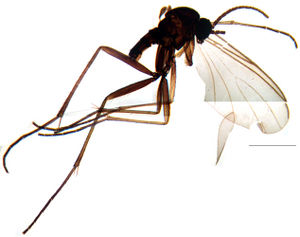Trichosiopsis krille
| Notice: | This page is derived from the original publication listed below, whose author(s) should always be credited. Further contributors may edit and improve the content of this page and, consequently, need to be credited as well (see page history). Any assessment of factual correctness requires a careful review of the original article as well as of subsequent contributions.
If you are uncertain whether your planned contribution is correct or not, we suggest that you use the associated discussion page instead of editing the page directly. This page should be cited as follows (rationale):
Citation formats to copy and paste
BibTeX: @article{Heller2012VeröffentlichungendesMuseumsfürNaturkundeChemnitz35, RIS/ Endnote: TY - JOUR Wikipedia/ Citizendium: <ref name="Heller2012Veröffentlichungen des Museums für Naturkunde Chemnitz35">{{Citation |
Ordo: Diptera
Familia: Sciaridae
Genus: Trichosiopsis
Name
Trichosiopsis krille (Heller, 2012) – Wikispecies link – ZooBank link
- Leptosciarella (Leptosciarella) krille Heller, 2012[1]: 99-100, fig. 4
Type material
Holotype ♂, no 9182 in MZH, Malaise trap, leg. J. Salmela,01.07.-03.08.2005
Type locality
Finland, Ks, Kuusamo, Uopajanpuro [in the original paper incorrectly written as "Vapajanpuro"]
Paratypes
Finland, 1 ♂, same data as holotype, MZH 9183; Czech Republic, 1 ♂, Bohemia, Spálenec, 48,56°N, 13,57°E, Feuchtwiese, Kescherfang, Barták, 12.05.1992, SDEI 2437.
Description (male)
Head. Eye bridge 3–4 rows of facets. LW-index of 4th antennal flagellar segment 2.1–2.8; neck 0.15–0.35 of segment width; Transition of basal part to neck pronounced. Colour of neck unicolour. Antennal hairs shorter than segment width; dense; salient. Palps darkened; normal; palpomeres 3. First palpomere elongate; with 4–6 bristles; with only some sparse sensillae. Second palpomere elongate. Third palpomere as long as first segment. Thorax. Colour very dark, or brown. Notum unicolorous. Thoracic setae long and strong; darkened. Mesonotum with some weaker central bristles. Posterior pronotum bare. Laterotergite bare. Legs. Colour yellow-brown, or patterned. Hind coxae darkened. Hairs on fore coxae bright. Front tibia apically with a patch of setae. Front tibial organ dark, or bright. Front tibial organ not bordered. Tibial setae on hind legs normal, shorter than tibial width, or very strong, as long or longer longer than tibial width. Tibial spurs of equal length. Claws untoothed. Wings. Wings slightly darkened; of normal shape. Wing membrane without macrotrichia. Wing venation weak, with faint m-base. M-fork of normal shape. R1 inserting at or slightly before base of m-fork; posterior veins with macrotrichia; stM mainly with macrotrichia; cuA1 and cuA2 mainly with macrotrichia; bM setose; r-m mostly setose; bM:r-M 0.6–0.8; st-Cu:bM 0.1–0.3; r1:r 1.45–1.7; C:w 0.55–0.7. Halteres dark; of normal length. Abdomen. Abdominal setae strong and dense; dorsally of different colour; ventrally white. Hypopygium concolour with abdomen; 0.7–0.8 × longer than wide. Base of gonocoxites with normal, weak hairs, or with strong setae; gonocoxites broadly separated; inner margin of gonocoxites normally U-shaped; inner part of hypopygium scarcely setose; elongated setae on valves of hypopygium absent. Gonostylus elongate; 1.9–2.5 × longer than wide; Inner margin concave; apex tapered. Apical tooth present; 2.3–2.55 × longer than broad; normal. Awl-like setae normal; on inner side of gonostyles present apically. Megasetae on inner part of gonostylus absent. Whiplash-hair absent. Tegmen rectangular with rounded edges; normal; Central process absent. Length of aedeagus/hypopygium 15–25 %; Aeadeagal apical structure present. Measurements. Body size 2.4–3.2 mm. Hind tibia 1.65–1.77 mm. Wing length 2.9–3.8 mm.
Diagnosis and discussion
Like Trichosiopsis alba, Tr. krille is another species, which is very similar to Trichosiopsis trochanterata. Just like Tr. trochanterata it has bright hairs at the first abdominal tergites and some strong bristles on the hind tibiae. It can be distinguished by the longer antennae, the bare posterior pronotum and the different shape of the gonostyli. In contrast to Tr. trochanterata the gonostyli are not parallel in Tr. krille but thickened at the base and clearly tapering apically. Another peculiar character are the bicolour femora, which are dark at the base and brightened towards the apex. Hereby Tr. krille resembles the also very similar species Trichosiopsis coarctata which can be distinguished by the presence of bristles on the laterotergite.
Etymology
The species was named after Kai Heller´s colleague, Christopher (“Krille”) Kutz.
Distribution
Czech Republic[1], Finland[1].
Images
|






